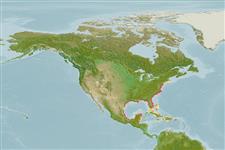>
Cyprinodontiformes (Rivulines, killifishes and live bearers) >
Fundulidae (Topminnows and killifishes)
Etymology: Lucania: Taken from the Italian province of Lucania, near tarento (Ref. 45335).
More on authors: Baird & Girard.
Environment: milieu / climate zone / εύρος βάθους / distribution range
Οικολογία
Θαλασσινό(ά); Γλυκού νερού; Υφάλμυρο pelagic-neritic; αμφίδρομο (Ref. 51243); εύρος βάθους 0 - 2 m. Subtropical; 10°C - 25°C (Ref. 2059); 43°N - 17°N, 98°W - 69°W
Western Atlantic: Massachusetts and northern Gulf of Mexico to Florida Keys in USA and northeastern Mexico. Ascends Rio Grande and Pecos River in Texas and New Mexico in USA (Ref. 5723).
Length at first maturity / Μέγεθος / Βάρος / Age
Γεννητική Ωρίμανση: Lm 2.5 range ? - ? cm
Max length : 6.2 cm TL αρσενικό/απροσδιόριστο; (Ref. 37039); common length : 3.7 cm TL αρσενικό/απροσδιόριστο; (Ref. 12193)
Μαλακές ραχιαίες ακτίνες (συνολικά) : 11 - 12.
Body shape (shape guide): fusiform / normal.
Inhabits vegetated quiet water and usually swims several inches below surface of water. 7 cm max TL (Ref. 5723). Feeds on larval crustaceans (mainly cyclopoid and harpacticoid copepods), mosquito larvae, small worms, and mollusks (Ref. 79012). Not a seasonal killifish. Is difficult to maintain in aquarium (Ref. 27139).
Huber, J.H., 1996. Killi-Data 1996. Updated checklist of taxonomic names, collecting localities and bibliographic references of oviparous Cyprinodont fishes (Atherinomorpha, Pisces). Société Française d'Ichtyologie, Muséum National d'Histoire Naturelle, Paris, France, 399 p. (Ref. 27139)
IUCN Red List Status (Ref. 130435: Version 2025-1)
Threat to humans
Harmless
Human uses
αλιεία: Εμπορικό(ά); Ενυδρείο: Εμπορικό(ά)
Εργαλεία
Special reports
Download XML
Διαδικτυακές πηγές
Estimates based on models
Preferred temperature (Αναφ.
123201): 12.7 - 26.7, mean 23.7 °C (based on 167 cells).
Phylogenetic diversity index (Αναφ.
82804): PD
50 = 0.6250 [Uniqueness, from 0.5 = low to 2.0 = high].
Bayesian length-weight: a=0.01202 (0.00616 - 0.02345), b=3.15 (2.98 - 3.32), in cm total length, based on LWR estimates for this species & (Sub)family-body (Ref.
93245).
Τροφικό Επίπεδο (Αναφ.
69278): 3.2 ±0.2 se; based on size and trophs of closest relatives
Ελαστικότητα (Αναφ.
120179): Υψηλό, ελάχιστος χρόνος για διπλασιασμό πληθυσμού < 15 μήνες (Preliminary K or Fecundity.).
Fishing Vulnerability (Ref.
59153): Low vulnerability (10 of 100).
🛈
Nutrients (Ref.
124155): Calcium = 407 [194, 1,040] mg/100g; Iron = 2.72 [1.33, 5.23] mg/100g; Protein = 18.8 [17.5, 20.2] %; Omega3 = 0.458 [0.204, 1.045] g/100g; Selenium = 8.46 [3.41, 21.28] μg/100g; VitaminA = 21.6 [6.4, 81.3] μg/100g; Zinc = 2.32 [1.44, 3.65] mg/100g (wet weight);
